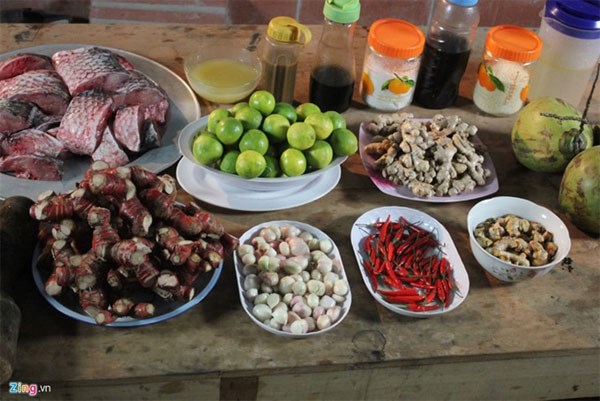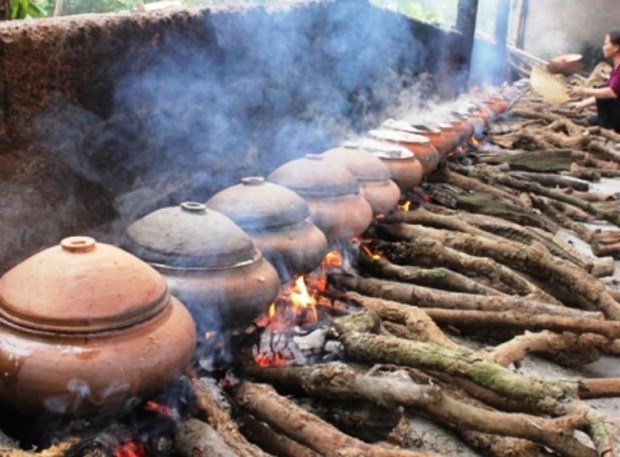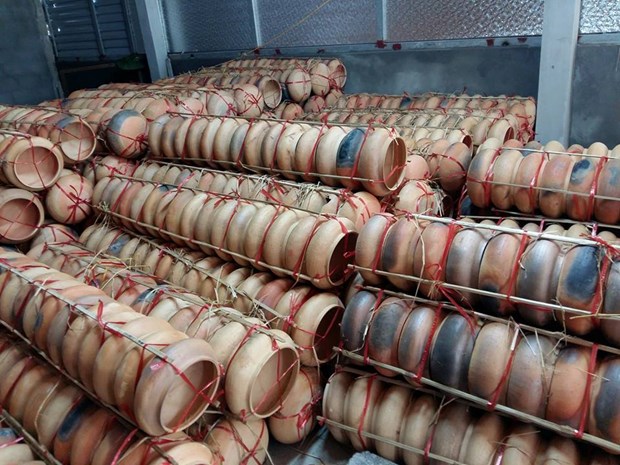
Potful: A pot of ca kho lang Vu Dai, braised fish, is ready for sale.
The
resident of Vu Dai Village in the northern province of Ha Nam likes to recall
the days when he and his fellow villagers earned their living mainly by
planting mulberry, raising silkworms and weaving silk.
Each
family had one or two ponds to raise fish, which was their main source of food.
“When
Tet came, Vu Dai villagers would catch a big black carp weighing about three
kikos or more, to worship our ancestors and pray for a healthy and lucky New
Year. This custom has been maintained from generation to generation until now,”
said Dat.
He
said that a long time ago, an ancestor named Tran Ba Nghiem, who had gone away
from home for many years to earn a living, returned to the village and began
braising fish in a clay pot, making a very fatty, tasty dish.

For the marinade: Ginger, chili, lemon and many other ingredients are used to marinate the fish before it is braised.
Now,
most Vietnamese inside and outside the country know about the dish, but what
makes it stand out is the collaboration it takes between the cooks and potters
from different regions.
Chefs
in Vu Dai have to co-operate with artisans from Nghe An, Thanh Hoa and Nam Dinh
to get clay pots and its covers, Dat, said, adding that even if there was small
thing lacking in the accessories, the fish pot would not have the specific
fragrance and flavour that made it famous.
Dat
said his family has ordered pots from Nghe An’s Do Luong District a year in
advance because the clay used is durable, and will not crack during the 16-hour
braising. The pot’s cover should be from Thanh Hoa because the potters make the
covers in “vault form” which is very easy to braise fish.

Slow cooking: Braising fish in Vu Dai Village, Ha Nam Province, takes about 16 hours. Photos dulichhanam.com
Before
braising the fish, a handful of rice has to be put into the pot, boiled for
several hours and dried under the sun for half a day to ensure it does not
crack, Dat said. The fish should be a black carp of between three and five kg
each that is cut it into big pieces, marinated with ingredients such as fresh
galingale, ginger, lemon, dried onion, pork broth, pork side, coconut milk,
fish sauce, chillies and pepper.
He
told Viet Nam News that the wood used to braise the fish should be longan wood
because it will help take out the muddy smell from the pot and give the fish
the most attractive flavor.
Galingale
and ginger should be placed at the bottom of the pot and then covered with the
above mentioned ingredients onto each layer of fish to ensure it does not burn
during 16 hours on the fire.
During
the process of braising, the fire should be kept light without being put out to
ensure a brown black colour. The fish should be firm, its bones soft, said Dat,
adding that they have to let the braised fish pot cool before packing to
deliver to their customers.
Dat
said he has asked all of his relatives to teach the job to youngsters so that
the skills are not lost when older villagers pass away.

Crack proof: Earthenware pots to braise the fish are imported from the central province of Nghe An’s Do Luong District.
A
younger villager, Nguyen Van Toan was the first to take Ca Kho Lang Vu Dai (Vu
Dai Braised Fish) to the internet and set up a delivery system.
Toan
said he set up his business aiming to develop and bring the traditional food
nationwide and world wide. He said he has received many orders to supply
braised fish the whole year round and for the traditional Tet holiday.
Nguyen
Hong Lam, a HCM City resident, said his family members including his great
grandfather enjoy this dish a lot. “I
always order a pot of Vu Dai braised fish for Tet (Lunar New Year). It is not
just appetizing; it is also a good digestive.”
He
said many of his friends also order the dish as a specialty food to welcome
Tet. Toan’s video on this dish (http:// cakholangvudai.com/video-ca-kho-vu-dai/)
has further popularised the dish around the world.
By VNS